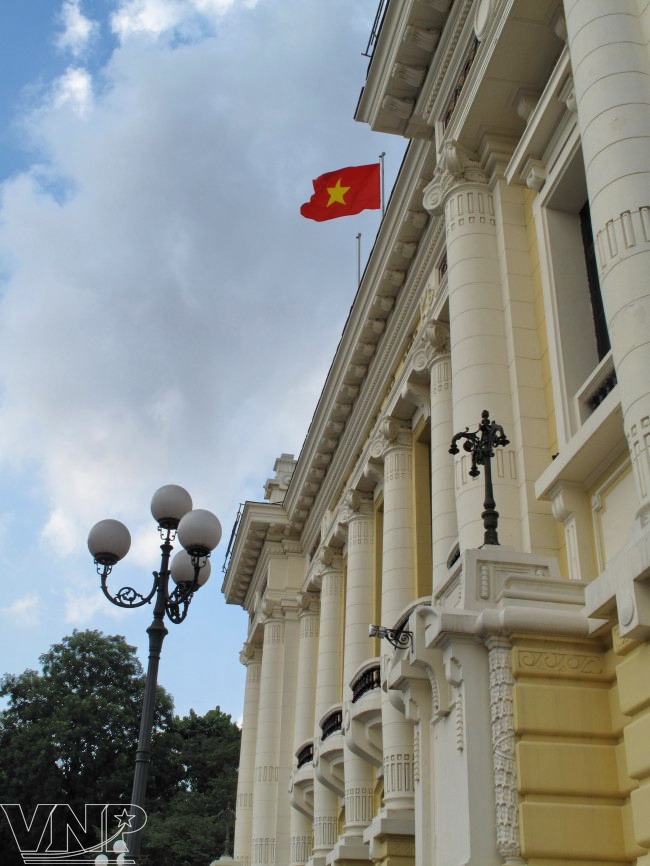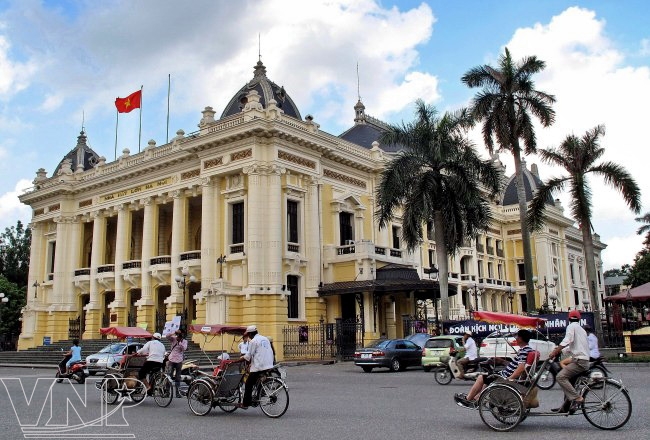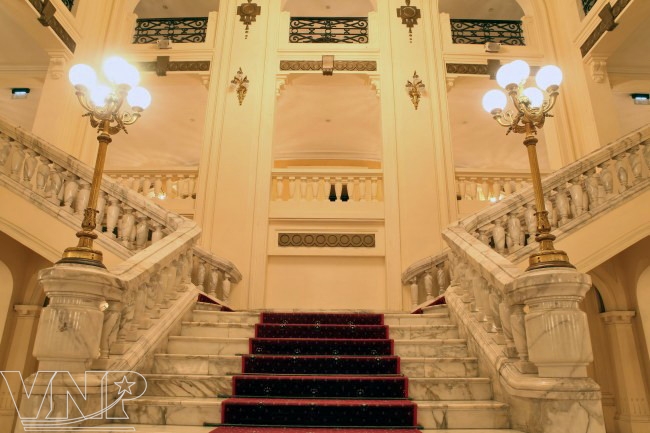The Hanoi Opera House is 100 years old this year. Having experienced so many ups and downs for more than a century, it remains intact and has become a great cultural destination and a beautiful architectural work of the 1,000-year-old city of Hanoi.
In the early years of the 20th century, to meet the demand for the work and relaxation of French government officials in colonial countries, including Vietnam, French architects built many office buildings and other magnificent works, including the Hanoi Opera House.
In 1899, chaired by Richard, the French Ambassador in Hanoi, the Hanoi City Council asked Governor Fourer to build a theater in Hanoi. The location selected for building the theatre was in Thach Tan and Tay Luong Villages in Phuc Lan Canton, Tho Xuong District.

The Hanoi Opera House at night.

Circular columns on the front of the Hanoi Opera House. 
The roof of the building. 
The statue of a stone lion on the roof of the Hanoi Opera House.

Some decorative designs on the roof of the building.

The Hanoi Opera House is imbued with the luxurious and splendid beauty of the French architecture. |
French architects Harlay and Broyer were the designers of the theatre. After several revisions, on June 7, 1901 construction started. As designed, the theatre has a total area of 2,600m2, is 87m long and 30m wide with the highest point being 34m. Due to its scale and complexity, ten years later the project was completed and the opera house was put into use.
According to historical documents, every day nearly 300 Vietnamese workers were involved in building the theatre. Over 35,000 bamboo stakes were placed and a 90cm-thick layer of concrete was poured in the swamp to reinforce its foundation. Over 12,000m3 of materials and nearly 600 tonnes of steel were used. The whole project cost about 2 million French francs.
Compared with Hanoi’s population of less than 20,000 people at that time the architectural scale of the theatre was large. It has a large stage and a hall with 870 seats. The middle floor has small boxes for special guests. Behind the main door is a large corridor with a wide stone-tiled staircase leading upstairs and two side stairs leading down to the basement. On the second floor there is a large mirrored room for the reception of distinguished guests. At the back of the theater there is an administration room, 18 make-up rooms for actors and actresses, two rehearsal rooms, a library and a meeting room.
A special feature of the Hanoi Opera House lies in its classical beauty which is reflected in every line and shape of the building. The opera house was designed in the European classical architectural style (the Renaissance) mixed with the architectural style of the Paris Opera House in France. So the entire building looks luxurious and magnificent.
After being inaugurated, the Hanoi Opera House became a center for classical artistic performances, such as opera, chamber music and drama. The audience at that time was mainly French officials of upper class and a few wealthy Vietnamese people.

The concert hall of the Hanoi Opera House has 870 seats.


Decorative patterns inside the building.

The main stairs leading to the second floor.

The lobby of the Hanoi Opera House.

The stairs of the Hanoi Opera House.

The main corridor of the Hanoi Opera House. |
When the August Revolution in 1945 succeeded, the Democratic Republic of Vietnam (DRV) was born, which also marked a new chapter of the Hanoi Opera House. The theatre has seen many important historical events, such as a meeting place to present the Viet Minh Front to the public, the first session of the National Assembly of the Democratic Republic of Vietnam and a rally to celebrate the first anniversary of the birth of the DRV government.
After a century of the theatre’s existence, in 1995, architect Ho Thieu Tri and other Vietnamese architects restored the theatre and embellished it to extend its use in the new era.
Now, the Hanoi Opera House is still a place to carry out great cultural activities of the country and it has become a beautiful symbol of architecture, culture and art of Hanoi.
Story: Huu Tuan - Photos: Tat Son